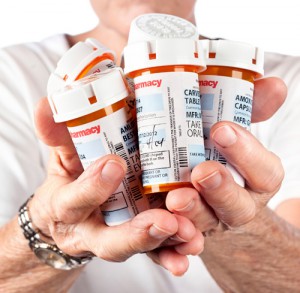 How many prescription drugs are you taking? One or two? You are not alone. Nearly 7 in 10 Americans are on at least one prescription drug, and more than half take two, according to a recent report by the Mayo Clinic and the Olmstead Medical Center.1 20 percent of us are on five or more.
How many prescription drugs are you taking? One or two? You are not alone. Nearly 7 in 10 Americans are on at least one prescription drug, and more than half take two, according to a recent report by the Mayo Clinic and the Olmstead Medical Center.1 20 percent of us are on five or more.
It appears that drugs are prescribed to both men and women across all age groups. High blood pressure drugs do skew towards older age groups, and those being treated average three pills a day.2 These new statistics are comparable to other reports nationally, says study author Jennifer St. Sauver, Ph.D., a member of the Mayo Clinic Population Health Program.
There is no denying that prescription drugs are lifesaving therapies in many cases. However, their use in this country has increased steadily over the past decade,1 and what’s more, overdoses involving prescription drugs are at new epidemic levels, now killing more Americans than heroin and cocaine combined.3 This startling fact, and action steps to address the problem, will be a key focus at January’s Clinton Health Matters Conference in La Quinta. (See Conference page 22)
How did we get here?
Why is prescription drug use so out of control? Is it because busy doctors often lack the time to address whole person care, and thus write prescriptions in a sincere effort to fix us to the best of their ability? Or are we as patients just looking for that quick fix? Numerous reports point to both. It is certainly interesting to note that the increase in use mirrors the FDA’s approval of pharmaceutical companies to advertise on TV (1997), a novelty in only two countries worldwide – the U.S. and New Zealand4. As such, it is not surprising that you will recognize some of the top selling drugs on the following chart (their promotional messages may even dance in your head).
What drugs are we taking?
It may be surprising to learn that two of the top three selling drugs are for depression (Abilify and Cymbalta)5, but not so when you consider the The Mayo Clinic findings: nearly 1 in 4 women ages 50-64 are on an antidepressant.1
The most often prescribed drug (in units) is the cholesterol-lowering drug, Crestor, which is one of four in the top ten for both units sold and drug sales. Joining this list is Nexium (“the purple pill”), Cymbalta, and the bronchodilator Advair Diskus.
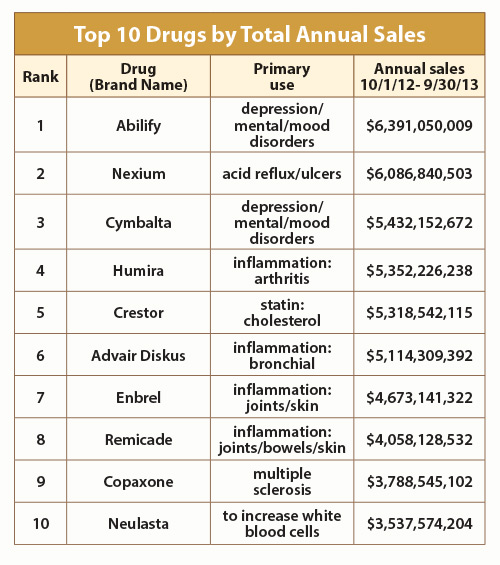
Why are we taking all these drugs?
Considering a second report from Drugs.com,6 we summarized the symptoms consumers are battling with all these prescription drugs, and the absolute forerunner was inflammation – of joints (arthritis), bowels (ulcerative colitis, Crohn’s Disease, IBS), and skin (psoriasis). Inflammation affects every cell in the body, and today’s medical community points to inflammation as a leading cause of chronic disease in this country, so it is no wonder we are popping pills.
Other top categories include acid reflux, depression, cholesterol, high blood pressure, asthma and pain.
What is there to do?
You know from their commercials, and hopefully your health care provider, that many of these medications can cause serious side effects. Others are not meant to be taken for long periods of time, which we often overlook as symptom relief from taking a pill makes us feel better fast.
If you currently take medications and would like to wean off them, or are considering starting a drug but want to research natural options first, there are usually lifestyle changes, foods, and natural vitamins, minerals and compounds that can aid your condition. It simply takes a bit of work and dedication, as well as, support from your health care provider or team. The number of doctors adopting this philosophy of integrative medicine is significantly increasing. In fact, Scripps Hospital in San Diego now offers board-certification in integrative holistic medicine (ABIHM).
If you seek the assistance of an integrative or naturopathic doctor, it is important that information is shared with your primary care physician or medical team. It is also important to note that you should never change or stop taking medication without first speaking with your doctor, and he or she should always be informed of any complementing treatment plan you begin.
Let’s take a look at some of the aforementioned symptoms and the lifestyle changes which can help minimize their effects. There are dietary recommendations for most and a trip to one of our neighborhood health food stores, like Clark’s Nutrition or Harvest Health Food, will introduce you to many natural aids. Both Clark’s and Harvest have knowledgeable staff to help you navigate their shelves.
Starkie Sowers, Director of Education for Clark’s, says it is important to note that their nutrition consultants do not prescribe or diagnose, but are there to share the science and research behind the products they offer. Their training is extensive and on-going.
Just as you should inform your doctor of any additions to your treatment plan, sharing your medications and health history with these nutritional consultants will help them to help you.
Inflammation
One of the simplest ways to help reduce inflammation is to avoid foods that cause it. As stated by local board-certified integrative medicine doctor Hessam Mahdavi, MD, in an earlier Desert Health® report,7 five of the top inflammatory foods are gluten (found in wheat and other grains), corn, dairy, soy, and refined sugars. Unfortunately, “the foods that are inflammatory are some of the most common foods we ingest through the standard American diet,” he said, adding that people suffering autoimmune disorders, such as lupus and osteoarthritis, can benefit significantly from this simple lifestyle change.
Great food alternatives include many readily available gluten-free products, brown rice pasta, bean chips, almond or coconut milk, and fresh seasonal fruit. And as renowned heart surgeon Dr. Steven Gundry of The Center for Restorative Medicine is fond of saying, “Eat things that eat green things” because most farm-raised chicken and beef are now being fed corn and soy, so opt for the grass-fed beef, or even better, wild fish.
According to Sowers, some of the natural ingredients that substantiate biochemical knowledge and aid inflammation include omega 3 fatty acids, vitamin D, digestive enzymes, msm, and curcumin which is extracted from the turmeric plant and found in spices like curry. “Inflammation is a very broad spectrum, and similar to medications, the many natural anti-inflammatories work in different areas of the body,” he says. For example, probiotics create an immune response in the gut and calm down inflammation, so they are effective with irritable bowel syndrome and ulcerated colitis. Omega 3 and quercetin are shown to be effective in decreasing joint inflammation.
Sowers adds that in this category, there are many multi-nutrient formulas that work in different areas.
Acid Reflux
The FDA recommends that treatment with proton pump inhibitors (PPIs like Nexium, Prolisec) not exceed 14 days, but many consumers often overlook this advice. Many are also unaware of the adverse and often severe side effects, or alternative treatment options. According to David S. Johnson, MD, of Premier Surgical Associates, 30% of PPI users don’t even have acid reflux. He adds that once properly diagnosed, there are lifestyle changes that can reduce symptoms.
In a related editorial for Prevention.com,8 Liz Lipski, PhD, CCN, author of Digestive Wellness agrees and adds that PPIs block the protective hydrochloric acid (HCL) in the stomach, which can lead to bacterial overgrowth in the small intestines and ultimately to mineral deficiencies by hindering their absorption. (See page 5 for more on PPIs.)
The simple solution once again is to avoid foods that cause the problem. We’ve all heard ‘avoid spicy foods for heartburn,’ but avoiding all trigger foods is important. Shannon Sinsheimer, ND of Optimal Health Center in Palm Desert, recommends a blood test to identify those from over 90 foods which commonly cause sensitivities and can result in acid reflux. She adds that managing stress is also an important factor.
Natural remedies include slippery elm which contains antioxidants that help relieve inflammation in your intestines and help protect your gastrointestinal tract from excess acid; marshmallow root extract, digestive enzymes and probiotics.
Cholesterol
The bad news is that bad cholesterol (LDL) is a leading cause of cardiovascular disease. The good news, however, is that there are a lot of good foods – such as garlic, olive oil, tree nuts, red wine and dark chocolate — which can help reduce inflammation in your body and have been proven to lower LDL and raise HDL (the good kind) naturally.
The secret to garlic’s heart-protecting powers is an amino acid called allicin, which is released when garlic is crushed. Allicin protects the heart by keeping cholesterol from sticking to artery walls8 and garlic supplements that contain allicin are now available without the strong garlic taste and smell.
“Fiber is amazing as well,” says Sowers. “Water soluble fiber helps prevent cholesterol absorption and helps modulate healthy HDL and LDL.” He also points to berberine which is found in plant roots, stems, and bark.
Red yeast rice is often used as a natural statin; however, the active ingredient in red yeast is the same as the active ingredient in prescription statins and thus, can have similar side effects, drug interactions, and precautions as statins. Do not take red yeast if you are already taking medications used for lowering cholesterol.9
Depression
Depression can be a serious condition ranging from mild to moderate to severe. Those on medication should never stop taking them without the guidance of a health care professional.3
Healthy lifestyle changes like exercising and meditation have been scientifically proven to alter mood and help with mild to moderate depression. Ensuring that your hormones are properly balanced is also important, especially considering that 1 in 4 women ages 50-64 are on an antidepressant which correlates with the menopausal stage in life. As reviewed in our last issue of Desert Health®, hormone replacement therapy can positively affect both your mental and physical well-being.
Research also finds that fish oil can have an anti-depressant effect.8 “Studies show that eating omega-3 rich seafood two or more times a week may be linked with a 50% lower rate of depression,” says Daphne Miller, MD, author of The Jungle Effect: A Doctor Discovers the Healthiest Diets from Around the World. She points to Iceland, where they eat a hefty 225 pounds of cold-water fish such as char, herring and cod per person per year and have surprisingly low rates of seasonal affective disorder and depression despite long, dark winters. By contrast, she states, Americans average 48 pounds of fish per person.8
To get your dose of omega-3s, opt for grilled salmon when ordering at restaurants, or make your own light tuna salad by mixing low-mercury canned tuna. Sardines are another great choice, says Dr. Miller. “If you are not a fish lover you can still get your omega-3s by eating leafy greens, seeds such as flax or pumpkin, walnuts, and free range meats.”
In natural supplements, St. John’s wort, a plant used for centuries by European countries to treat mild to moderate depression, still leads the category. Research supports its effectiveness; however, it may take 2 to 3 weeks for St. John’s wort to improve depressive symptoms.9
Adopting new habits to improve your health is a lifestyle change and not merely a phase. It takes a shift in mindset to release the idea of prescription drugs as the easy fix, and it is important to have a supportive health care team. Taking pro-active steps to manage your medical conditions through nutrition, exercise, and stress relief is a primary factor to longevity and quality of life.
For additional information on natural remedies for medical conditions, consult with your health care practitioner.
References: 1) Nearly 7 in 10 Americans Take Prescription Drugs, Mayo Clinic, Olmsted Medical Center Find June 19, 2013 www.mayoclinic.org/news; 2) American Heart Association, Tasty Topics presentation, Dr. Philip Shaver, MD; Dec. 2013, Palm Desert; 3) Centers for Disease Control and Prevention (CDC). Vital Signs: Prescription Drug Overdoses in the U.S. 2011. Web. 01 May 2013.; 4) Chronology of Direct-to-Consumer Advertising regulations in the United States by Scott A. Mogull, MS, MA Austin TX. AMWA Journal Vol. 23, No.3, 2008; 5) Top 100 Selling Drugs in the U.S. Oct. 1, 2012 – Sept., 30, 2013. IMS Health.; 6) Drugs.com: US Pharmaceutical Sales – 2013; 7) The Food and Inflammation Connection by Maura Ammenhauser. Desert Health March/April 2012; 8) Natural Alternatives To The Top 10 Most Prescribed Drugs By Holly C. Corbett for Prevention.com http://www.prevention.com/mind-body/natural-remedies/top-10-prescription-drugs-and-natural-remedies; 9) WebMD.com;







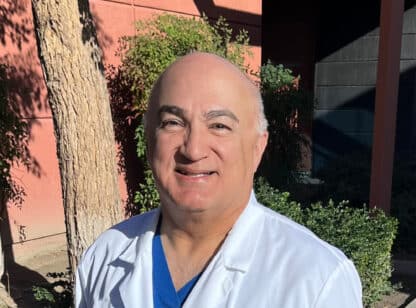

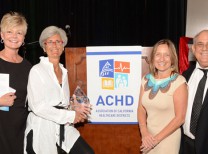











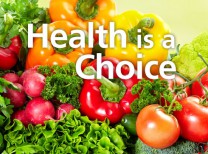




























Comments (0)